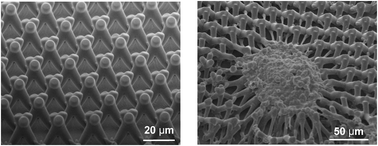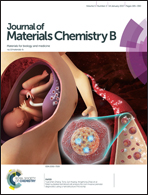Culture substrates made of elastomeric micro-tripod arrays for long-term expansion of human pluripotent stem cells†
Abstract
Culturing and expansion of human pluripotent stem cells (hPSCs) depend on the chemical and physical properties of the substrates. Gel-coated substrates providing low stiffness are commonly used for long-term pluripotency maintenance of hPSCs. We previously reported that gelatin nanofibrous substrates also allow long-term culturing of hPSCs, suggesting the importance of three-dimensional (3D) organization of extracellular matrix proteins. To further evaluate the significance of 3D features and material stiffness, we fabricated elastomeric micro-tripod arrays (MTAs) and maintained hPSC propagation over 10 passages without observing the pluripotency loss or the development of chromosomal abnormality. We also found that the hPSC colonies on MTAs were more rounded than those on gel-coated flat substrates. Theoretical analyses suggested that the effective stiffness of elastomeric MTAs is comparable to that of gel-coated substrates and that the effect of structural anisotropy is negligible. Cells on MTAs benefit from enhanced diffusion underneath the hPSC colonies as well as enzyme-free detachment from the substrate during passage.



 Please wait while we load your content...
Please wait while we load your content...